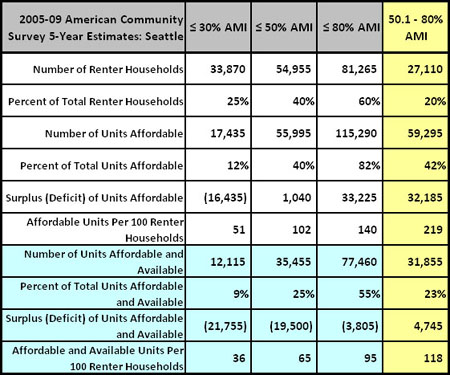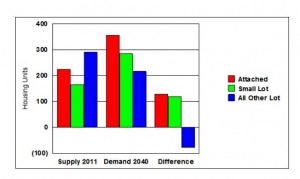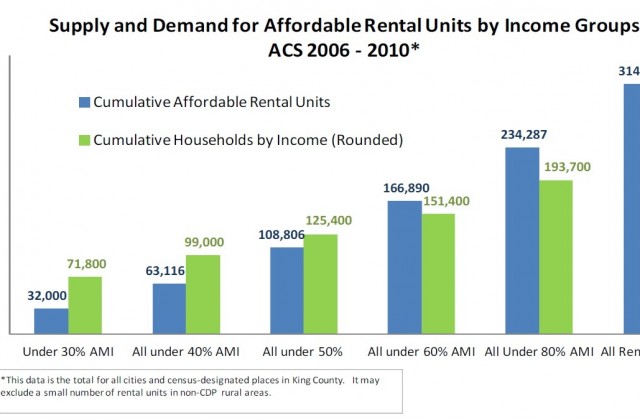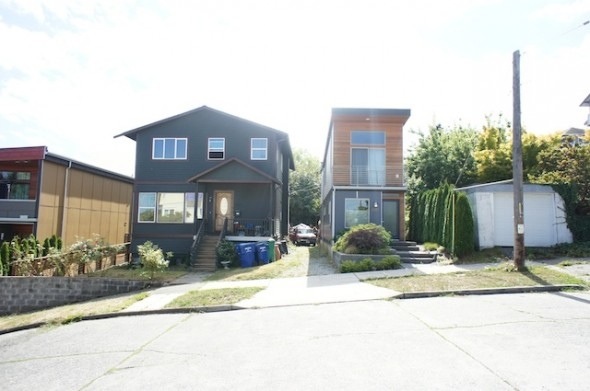Innovation in Affordable Housing
Innovation happens in affordable housing, but progressive cities such as Seattle who have chosen to make it a priority could be doing more to encourage creativity in developing new models. City planners are on board with the value that mixed income living brings to neighborhoods, but regulators too easily think in terms of twisting the arms of big developers, and too little about encouraging the outlying ideas.
Take Apodment microhousing. The family run company has made huge strides in popularizing and normalizing cluster style apartment living, but has had an uphill battle against confused and worried neighbors and city officials. Inviting concerned parties to visit the developments has helped, as has the fact that the locally owned company makes responsible and sensitive management a priority of doing business. One look at old photos of the blighted properties replaced should convince any skeptic that changes are a step in the right direction. This model has worked because of the careful attention by the developers to the peculiarities of Seattle–but it has also only been possible in spite of overly prescriptive zoning laws.
Other models have succeeded at least as far as proof of concept. Artspace, based in Minneapolis, has developed 35 sites in 13 states through what they call an artist-led community transformation. Rainier Beach is home to one such project, where studio and residence are blended and communal amenities entice arts minded tenants. Fundrise, in Washington, D.C., hopes to make its name by showing that crowdsourced finance can work in real estate development. Again, one of their major challenges will be navigating regulations designed for a bygone age.
Not every fresh idea is going to work, and some concepts can and should be specific to particular projects. But innovation should be encouraged, not given obstacles. Seattle’s Homestead Community Land and Trust is a strong example of working to bring home-ownership within the reach of the bottom half of earners. But their focus on single-family, town-home, and condominium style housing won’t be a perfect fit for all homestead hopefuls.
Cohousing is often a way to pursue doing life together with like minded folk–owning a goat or sharing home-grown meals, for example. Unfortunately that vision of residential life has been within reach only for the financially free. Models like N Street in Davis, California have shown this way of life to be possible. Though this strain has more in common with American homesteading tradition than condo life does, it requires lawyers and bankers and organization at a cost and sophistication which 19th century American would have balked at.
A truly sustainable housing solution for this century will need more than mixed price points of entry. It will need a variety of ways of life which provide for degrees of self-reliance on the lot and block scale. Cities should back away from prescriptive regulations about configuration, and set results oriented goals around resource use. Subsidies and funded programs should include support for local scale ideas. A portfolio of tested concepts could make urban homesteading focus less on proximity to coffee shops and more on food and electricity production and water and waste management. Affordable housing initiatives should negotiate legal and urban design expertises with community organization to make it easier for groups to create their own living conditions–not just wait for a big developer to meet their needs.
Ivan Heitmann is a Masters candidate in the Landscape Architecture department at the University of Washington. He likes living in a tiny inexpensive apartment.
Eppur si muove! Housing prices do go down!
I’ve been on a Galileo kick lately. Galileo was the Italian astronomer who, using his telescope, argued in favor of the crazy idea advanced by fellow astronomer Copernicus that the Sun, not the Earth, is the center of the solar system. Both men faced lots of skepticism. “C’mon, Galileo,” even the most friendly church official said, “the Earth moves? It feels pretty firm to me!” The establishment’s resistance to the notion was so strong Galileo found himself in a church prison forced to recant. Legend has it that after he was tortured, as he walked away he muttered, “Eppur si muove!” or “And yet it moves.”
Many of us feel the Galileo sensation when arguing in favor of increased housing supply to stabilize or lower housing prices. The resistance takes the form of outright denial, “it doesn’t work like that, housing is more complicated,” (Housing is not bananas!) to the mild, “sure, more housing will help keep prices from rising, but they’ll never go down.”
Behold the Seattle Times article of last month headlined Seattle-area apartment rents may stabilize, even dip in 2014:
Developers have about 14,140 apartment units under construction and will deliver more than 9,700 in 2014, Cain estimates. Even if job growth remains steady, he said, the swelling supply will spur more competition for tenants and slow rent hikes.
It’s already starting to happen in Seattle’s Ballard neighborhood, which saw a massive buildup of new apartments.
The submarket had the biggest increase in vacancies in the fourth quarter, nearly 2 percentage points, though the overall vacancy rate is still below 5 percent — considered a tipping point in the balance of power between tenants and landlords.
Rents in Ballard still rose, Apartment Insights reports.
The article points out that rents will likely drop in the Seattle because of increased supply. Yes, right there the Seattle Times printed those words: “rents will likely drop.” Is this the result of legalized marijuana impacting journalism? No. It’s simply a boring real estate story describing what people in the industry already know, when vacancies go up, rents go down. I don’t speak Italian but Google Translate says, “Eppure si cadono!” Prices do fall when supply goes up. Will your landlord knock on your door and hand you a notice lowering your rent? Probably not, but overall rents do go down as vacancies increase.
Things are shifting in Ballard but probably not as much as they have in other neighborhoods. That isn’t surprising considering the ways that Seattle’s approach to land use makes it harder and more costly to build housing of all types. And yes, the City Council is looking at changing the LR3 Zone in Ballard to limit density there. This is exactly the wrong time to do that since, as the article points out, there is a shift in the “balance of power between tenants and landlords.” Isn’t that why Seattle voters cast ballots for Sawant, to sock it to The Man? Well the best way to do that is to let him build more housing!
I’ve been writing about how increasing housing supply would help lower housing prices since at least 2011.
We can keep larding up our code with all kinds of limits to the supply of new housing. Lower supply, increasing or steady demand, and then you have “unaffordable housing.” Why is this basic and iron clad rule of economics so hard to understand. I’m a philosophy major! Even I get this.
I have plenty of hair on my head, but I won’t for long if the City Council can’t get their basic economics straight. … If the people don’t come, and we have an over supply of housing, SHAZAM, we’ve just solved our affordable housing “crisis.”
I’m no Galileo, but we’ve got to stop hedging about what will happen to our housing market if we allow more building. If prices drop too low, and developers stop building, then would be the time to kick in real incentives to do so, not fees and tolls we call currently call incentive zoning. The most efficient and economical way to build more housing in a compact place is taller, more densely populated buildings. As we create more jobs and win more Super Bowls, more people will want to move here to join us in building the future of our city. All those wonderful people moving here will need lots of great housing options. Let’s make that easier to do.
Image of Galileo from Wikipedia Commons.
The Inconvenient Truth About Workforce Housing
For the better part of the past decade, both advocates and policymakers have been decrying Seattle’s perceived lack of housing affordable to people with incomes in the lower-middle range—so-called “workforce housing.” As a result, Seattle has implemented and is continuing to expand a program known as Incentive Zoning intended to create subsidized workforce housing through fees imposed on new development.
But there’s one rather important thing wrong with this picture: Available data show that there is no shortage of workforce housing in Seattle.
For reference, workforce housing is typically defined as housing that is affordable to households with incomes between 60 and 100% of area median income (AMI). In Seattle, 80% AMI currently corresponds to $49,440/year ($24/hour). Assuming the standard that 30% of income is spent on housing, that translates to an “affordable” rent of up to $1342 per month.
For all the attention workforce housing gets, there’s surprisingly little up-to-date, hard data available on how much housing is out there priced at workforce affordability levels, compared to how many households there are that need it. King County analysis based on a 2009 survey of market-rate rentals found that a whopping 83% of units in Seattle were affordable to a household earning 80% of AMI. For 50% AMI, 37% of Seattle’s rental units were affordable. Across King County and the greater region, data reveal a similar pattern of excess housing supply at workforce income levels, along with a sharp increase in need the further income drops below workforce levels.
Based on the raw numbers there would seem to be plenty of existing workforce rental housing in Seattle, but one complicating factor is that some households may be renting housing that is cheaper than what they could afford according to the standard 30% formula. This “downrenting” has the effect of reducing the availability of housing that is affordable to lower incomes. The affordable housing advocacy group Housing Development Consortium has published some analysis by the Seattle Office of Housing on downrenting, and the results are summarized in the table below:

Looking specifically at households with incomes between 50 and 80% of AMI (yellow column)—which is the lower portion of the workforce range—there was a surplus of over 32,000 housing units with affordable rents. Put another way, for every 100 households in the 50-80% AMI range, there were 219 affordable rentals in Seattle.
After subtracting the number of units being rented by households earning more than 80% of AMI, there is still a surplus of 4,745 rental units affordable and available to 50-80% AMI households; for every 100 households in the 50-80% AMI range, there were 118 affordable and available rental units in Seattle. In other words, even when downrenting was accounted for, there was still no shortage of workforce housing.
Since 2009 housing costs have risen faster than incomes, so current data would likely show some reduction in affordability. And rents vary significantly between different neighborhoods. But even with those caveats, it’s hard to imagine how anyone could interpret the available data as proof of a dire need for programs to subsidize workforce housing in Seattle. Yet currently Seattle City Council’s affordable housing efforts are focused on an extensive examination of how to do exactly that using Incentive Zoning. Here’s how Council justifies it:
“For example, a public school teacher’s starting salary of $42,000 suggests that he or she should not pay more than $1,050 per month (30%) for housing. Yet the average rent in Seattle for a 2 bedroom / 1 bath apartment is $1,466.”
That’s right, we have a workforce housing crisis because a single person earning far less than the City’s average income can’t afford the City’s average rent for an apartment with an extra bedroom, never mind the half of the housing stock that rents below the average. And so apparently therefore we need to exact a toll on new development through Incentive Zoning so that someone making up to $49k can live in a subsidized apartment in a brand new downtown high rise. Seriously—if any of you reading this were in those shoes, would you feel entitled to that?
Meanwhile Council balks when it comes to solutions that would support meeting workforce housing needs through private development—no public expense necessary—such as microhousing, accessory dwelling units, meaningful upzones in lowrise zones, removing off-street parking requirements, and other strategies that could reduce the cost of producing housing.
In previous posts I have pointed out the numerous flaws in Incentive Zoning—how it defeats its own purpose by restricting supply and increasing the cost of housing production, how it’s based on an outdated paradigm that sees dense development as negative impact to be mitigated rather than a critical sustainability solution, and how its inherent limits preclude it from ever generating more than a drop in the bucket relative to the need.
Now we can add to that list of flaws the fact that Seattle’s Incentive Zoning Program was designed to subsidize workforce housing, even though the data indicate that the City already has enough. Available workforce housing may not be brand new housing. But even if new housing has rents higher than workforce affordability levels, it will still help preserve the availability of workforce housing by absorbing demand from high-income renters who would otherwise be competing for, and driving up the prices of existing housing.
The City’s real housing need is at the deeper affordability levels, as the data clearly show an increasing deficit of affordable rentals as incomes drop below 50% AMI (see data table above). And yet another pitfall of Incentive Zoning is that even though it doesn’t address the real need, it creates the false impression that electeds are taking meaningful action to solve a housing problem. That is, Incentive Zoning is a politically expedient distraction.
To sum it up succinctly: Why are we applying an counterproductive tool to solve a problem we don’t have? We can and must find better solutions to address Seattle’s actual affordability needs.
>>>
Dan Bertolet is an urban planner at VIA Architecture and blogs at Citytank.
Housing Forum on February 13th
This Thursday, February 13, the Seattle City Council will be hosting an Affordable Workforce Housing Forum at City Hall. You can find all the details, including the agenda, on the Council’s website. You can also sign up there to attend all or part of the forum.
We’ve already covered this topic earlier pointing out that the problem of workforce housing really isn’t a problem at all. In fact, it looks like the City is trying to solve a problem we don’t have using a tool that really won’t work, incentive zoning.
There is no doubt that many people struggle to find a place to live in Seattle that meets their needs. Sometimes what they find isn’t satisfying because of the price. Other times the location could be a better fit for their needs. But anyone who has looked for a new place to live will tell you it’s not fun. The question is where in the housing market is the biggest problem; where are people being forced into unsustainable arrangements that are inconvenient and financially untenable?
The evidence is pretty clear (see the chart above from a King County needs assessment) that the greatest pain being felt in the housing market by consumers is at the lower levels of income (i.e. households that earn less than $42,000 per year). There are a number of reasons for this, but it is pretty hard to argue that we should be taxing new housing in our city to subsidize housing that the market is already producing. What would help all levels of income in the city is more housing production of all types. Right now the City Council is trying to find ways to generate revenue from adding costs to new housing to, ironically, subsidize the increased costs of housing.
We need a new and fresh approach to this discussion. Attend the forum and let the Council know your thoughts.
Seattle Workforce Housing Forum
Thursday, February 13
Seattle City Hall, 600 4th Avenue, 1st Floor, Bertha Knight Landes Room
Noon – 4:30 p.m. – Expert Panel and Stakeholder Engagement Discussion
4:30 – 6:00pm – Informal Gathering with Panelists
6 p.m – 8 p.m. – Public Feedback Session
Join us as we tackle the best ways to meet Seattle’s affordable housing needs! We’ll hear from national experts about workforce housing production in cities like Seattle, and how we can make the smartest decisions possible going forward.
The forum will include discussions on:
- Ideas how to Increase the Affordable Housing Supply
- Seattle’s Current Housing Programs
- Innovative New Strategies for Workforce Housing
- National Best Practices in Incentive and Inclusionary Zoning
12 noon – 4:30p.m.
Expert Panel and Stakeholder Engagement Discussion is generally geared toward stakeholders in the housing/development/advocacy field. After the panels, there will be an informal no-host happy hour at the Polar Bar for further discussion between participants and panelists.
6 p.m – 8 p.m.
Public Feedback Session is geared toward the general public
The City is currently evaluating the best methods increase the supply of affordable housing in Seattle by engaging with national experts, consultants, stakeholders, and the public. This forum will help inform City Council’s work going forward. Both events are free, and the public is welcome to attend either or both.
Big demand for small homes on small lots
Take a read through this great post by Kaid Benfield on the Ten things planners need to know about the future real estate market. Among other things, Benfield points out that a recent analysis
Suggests that the growth in demand for new housing over the next 30 years will consist primarily of demand for smaller homes on smaller lots, a reversal of the type of demand that fueled sprawl in the late 20th century.
The research Benfield reviews is from a book called Reshaping Metropolitan America, a study that shows a general trend away from larger homes on larger lots and toward more efficient and sustainable use of  land in cities. This is data that validates the bedrock principles of Smart Growth Seattle, especially our point that smaller homes are more efficient. We think they also make great neighbors.
land in cities. This is data that validates the bedrock principles of Smart Growth Seattle, especially our point that smaller homes are more efficient. We think they also make great neighbors.





